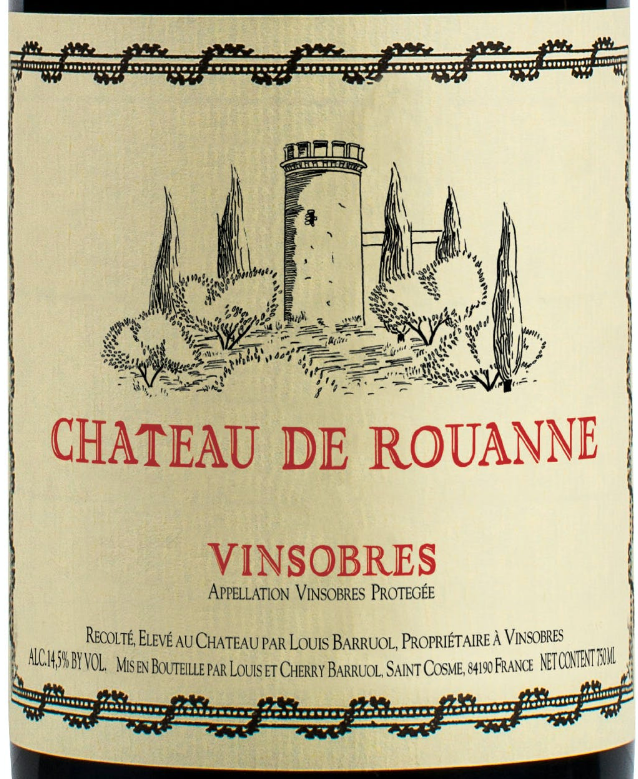Château de Rouanne 2019 Vinsobres Guerin 93
by Robert Millman
Vinsobres is the northern most appellation in the southern Rhone. It is distinguished from its Rhone relatives by having the coolest micro climate in the south. Like Gigondas, it’s relatively cool-climate region is due in part to the “pontias”, a cold, nocturnal wind that blows down from the Alps into the valley through the town of Nyons. In 2019 the irrepressible Louis Barruol, proprietor of the famous Château St. Cosme in Gigondas bought best domaine in Vinsobres, Château de Rouanne. He had been fascinated by the terroir and potential of Vinsobres for some time. Both the terroir and the climate of Vinsobres make it the best area in the southern Rhone for Syrah which plays a much bigger role than it does at the St. Cosme Gigondas. As he points out in a video interview, the best sites in Vinsobres combines two soils which are rarely found together: limestone and iron. The Château du Rouanne has three lieu-dits: Guerin, Barruol’s first release, is from the lower part of the domaine.
This was the first time I tasted the wine. Pairing it with the Gigondas allowed tasters to experience just how important terroir and microclimate differences are in determining the taste and texture of wines from the two regions. The Vinsobres is rather the richer, darker, more brooding of the two wines. Intimations of Hermitage in the northern Rhone are evident in every sip. The wine is about as far away in flavor and palate impact from Châteauneuf du Pape as any southern Rhone can be. The fine acidity which coursed through the wine balanced the weightiness. Dense, chewy yet surprisingly fresh and lively, the wine speaks the language of the southern Rhone, but in northern clothing. Barruol believes that his wines need at least a decade for all the nuances and hidden texture imparted by the terroir to fully emerge. How many buyers will wait that long? As powerful and deep as the wine is today, it is quite pleasurable. Buyers should open a bottle soon and keep a few for the future. Drinking Window: 2023-2035.
Isole e Olena 2013 Cepparello Toscana 97

by Ian D’Agata
Cepparello is one of Italy’s thirty best wines, and it’s top twenty if we limit that list to red wines only. The brainchild of Paolo De Marchi, who has run the Barberino Val d’Elsa estate (or more precisely, in the locality of Isole, in the territory of Barberino Tavernelle) with passion, flair and style for over forty years (the winery was actually founded in 1956), it’s glorious legacy will now be continued by EPI, the independent family group owned and managed by Christofer Descours (EPI is an investment company that already owns Tuscany’s Biondi-Santi estate as well as Piper-Heidsieck, Charles Heidsieck, Rare Champagne and Tardieu Laurent, besides other divisions devoted to fashion and real estate) that bought Isole e Olena in June 2022. However, De Marchi will be staying on for a while yet to help with the transition.
Cepparello was one of the first 100% Sangiovese Supertuscan wines created (in poor vintages, De Marchi used to blend in up to about 8% Caberent Sauvignon) to fully showcase what Italy’s most planted wine grape variety could muster if and when tended to with care and competence. Over the years, there has been a long lineup of remarkably great Cepparello wines, and the 2013 belongs squarely in the top tier of those marvelous bottles. A cool classic vintage, the wines of 2013, the best of which are complex, concentrated and refined, were great throughout both Chianti Classico and Montalcino, and Cepparello was one of the best of the best that year. The 2013 Cepparello Toscana Rosso is a bright dark red in colour, of almost translucent beauty (no ruby to speak of here). It boasts captivating aromas of red cherry, redcurrant, incense, bay leaf, camphor, licorice, fine leather, flinty minerality and herbs. Then brooding and initially shut down in the mouth, but hints at a strong mineral underpinning to its flavours of red fruits, forest floor and leather, and becomes increasingly lush and layered with aeration. The finish is beautifully delineated and focused, and features polished, rising tannins that nicely frame the deep, richly fruity, stony, and herbal nuances that linger long after the last sip and swallow. A knockout wine that is good to drink now (just make sure you decant it two hours ahead for maximum enjoyment: it’s amazing just how great this blossoms in the glass) but will be even better with another couple of years in the cellar, and then last another fifteen after that with ease. Drinking window: 2024-2035.

 中文
中文



